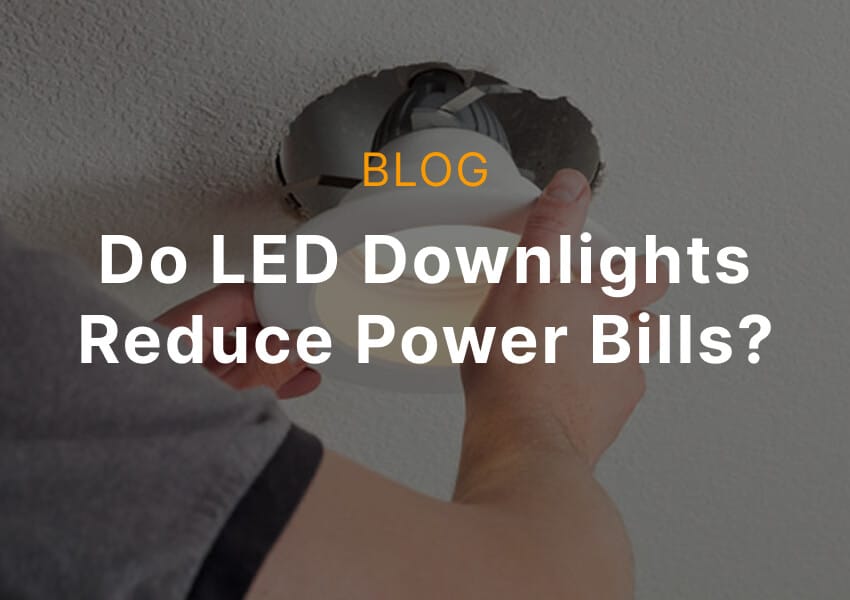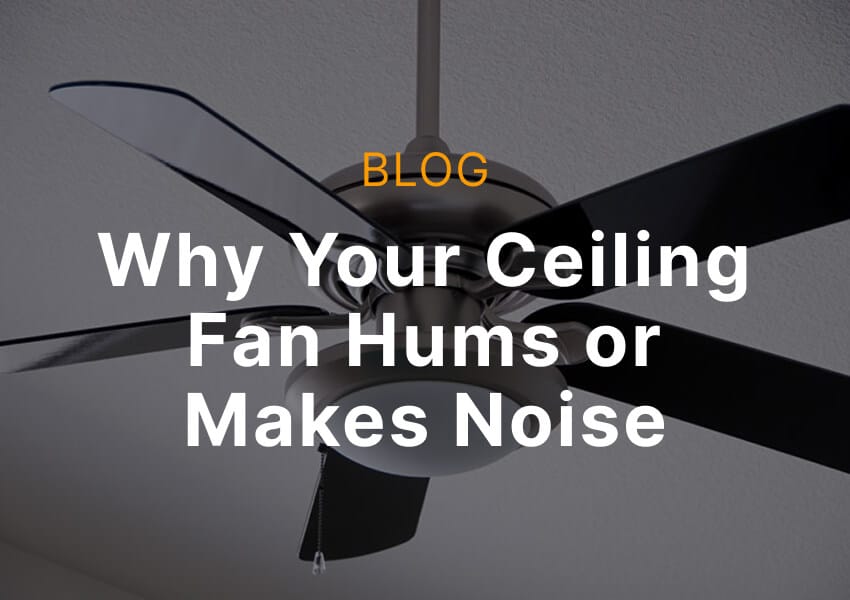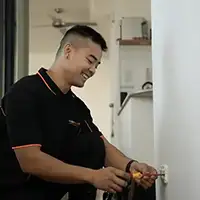Keeping your home safe for children begins with a simple but often overlooked task: securing powerpoints and electrical cords. Toddlers are naturally curious, and that curiosity can lead them toward sockets, plugs, and extension cables. Learning how to child-proof powerpoints and electrical cords is one of the easiest and most effective ways to reduce household hazards.
Every year, Australian hospitals treat children for electrical injuries at home. Most of these incidents can be prevented through small safety measures and professional advice. In this guide, you will learn how to spot potential risks, install protective devices, and understand when it is time to contact an electrician for professional electrical services. By the end, you will know how to create a safer environment for your family while keeping your electrical systems convenient and efficient.
Why Child-Proofing Powerpoints and Electrical Cords Matters
Electrical outlets and cords are everyday items that can pose serious risks to curious toddlers. Understanding why protection matters helps parents prevent accidents before they happen and create a safer environment for their children.
Hidden Dangers in Your Home
Most electrical outlets sit low on walls, right within a toddler’s reach. Without covers, small fingers can easily find their way inside, causing burns or shocks. Tangled or damaged cords also increase the risk of tripping or fire.
In many Australian homes, electrical injuries occur because safety devices were missing or outdated. Simple solutions such as outlet covers or tamper-resistant sockets dramatically reduce these dangers. Investing in prevention means protecting both your child and your peace of mind.
Early Prevention Saves Lives
Preventing electrical accidents does not require expensive upgrades. Start with basic measures like using baby-proof powerpoints Australia products and checking for frayed cables. Regularly inspect powerboards and unplug unused devices.
The cost of prevention is small compared with the potential consequences of a serious incident. Parents who stay proactive not only safeguard their children but also teach valuable habits about safety and awareness that can last a lifetime.
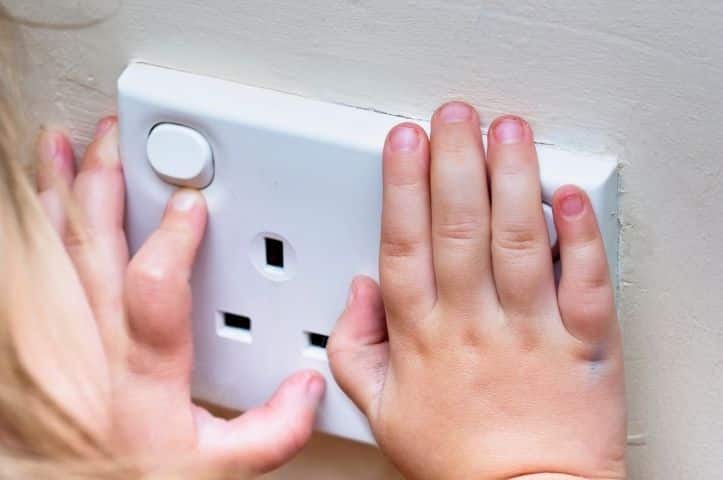
Common Electrical Hazards Around Children
Understanding where risks come from helps you address them before accidents occur. Here are some of the most common household electrical hazards that put curious toddlers at risk each day:
Powerpoints Within Reach
Children explore the world with their hands, which makes low powerpoints one of the most overlooked dangers in family homes. Toddlers can insert fingers or small objects into sockets, leading to serious shocks or burns.
Installing power point safety covers for toddlers prevents access to live points while still allowing parents to use them when needed. Many Australian homes now rely on modern outlet protectors designed to baby-proof powerpoints Australia and meet strict safety standards. Keeping these safeguards in place at all times is one of the simplest ways to protect your child.
Dangling and Loose Cords
Loose or hanging cords can be equally hazardous. A child might pull on a lamp cord, drag down heavy devices, or chew through insulation. Always shorten cords using clips or tubing to secure electrical cords from children and keep them out of reach.
Regularly check that cables are undamaged and never overloaded. By organising cords properly, you can prevent both tripping and electrical injuries. Good cable management also helps your home look neater and safer.
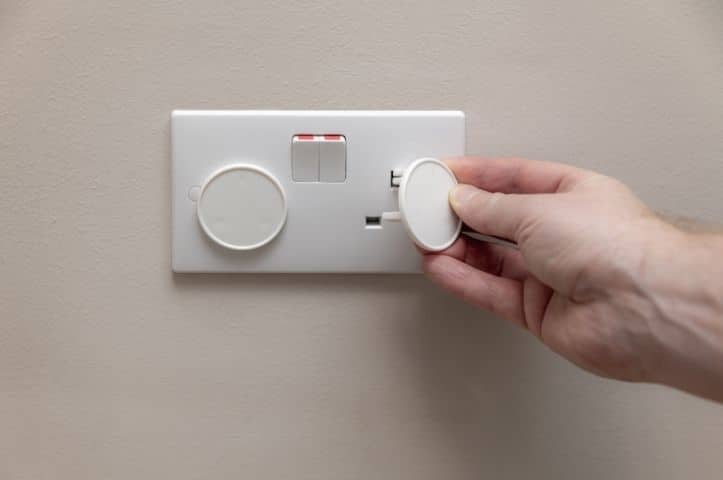
Step-by-Step Guide to Child-Proof Powerpoints and Electrical Cords
You do not need to rewire your entire home to improve safety. Follow these practical steps to make your electrical setup safer for young children and prevent avoidable household accidents:
Install Safety Covers and Guards
One of the easiest and most effective safety upgrades is installing outlet covers or tamper-resistant fittings. Products like child safe plug covers Australia are designed to block curious fingers from reaching live contacts. Another option is power point tamper resistant outlets, which automatically close internal shutters when a plug is not inserted.
These covers are affordable, widely available, and quick to fit. Always choose products that meet Australian electrical safety standards and replace them if they show any wear. If your outlets are older or damaged, have a residential electrician inspect them for compliance and safety.
Manage and Conceal Cords
Cords can quickly become dangerous if left loose or tangled. Good cable management for a child-safe home makes a big difference. Use cord clips, cable boxes, or floor covers to reduce tripping and chewing hazards.
Learn how to hide electrical cords so toddlers can’t reach by tucking them behind furniture or running them through wall conduits. Avoid placing cords near beds, cots, or play areas where children might grab or bite them. When cords are kept organised, your home stays both safer and tidier.
Replace or Upgrade Unsafe Outlets
Older powerpoints can loosen over time or lack modern safety features. Upgrading to newer outlets that comply with electrical safety for children home Australia standards ensures ongoing protection. Check for cracked plates, scorch marks, or sparking, which indicate the need for replacement.
A licensed electrician can assess your system, replace outdated fittings, and verify that your wiring meets AS/NZS 3000 regulations. Preventive maintenance like this eliminates potential hazards and gives parents peace of mind knowing their home is secure and compliant.
When to Call a Licensed Electrician
Some electrical fixes are simple, but others require the expertise of a professional. Knowing when to seek help ensures your safety and prevents small issues from becoming serious hazards:
Persistent Electrical Issues
If you experience flickering lights, tripped circuits, or warm powerpoints, do not ignore them. These symptoms often signal wiring faults or overloaded outlets. Asking when I should childproof powerpoints in my home is a good starting point, but ongoing electrical problems demand immediate attention from a qualified electrician.
A professional can test your system, replace faulty components, and confirm that your setup meets Australian safety standards. Early intervention prevents damage, protects your family, and reduces the risk of fire.
Installation or Outlet Upgrades
Replacing old outlets or installing new ones might seem straightforward, but working with electricity is never risk-free. A licensed electrician guarantees correct installation and compliance with AS/NZS 3000 regulations.
When deciding on DIY versus professional help, consider cord covers effective for child safety and whether your existing setup provides adequate protection. Expert installation ensures all devices are safe, durable, and properly connected to your home’s electrical system.
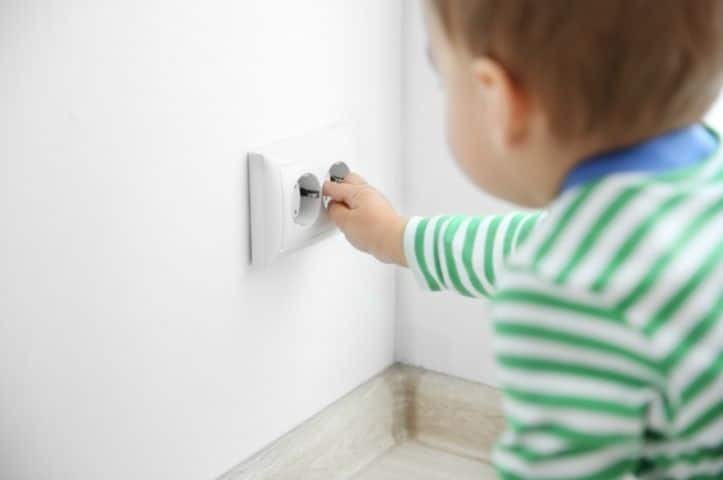
Maintenance Tips for Long-Term Electrical Safety
Electrical safety is not a one-time project. Regular checks and maintenance keep your home safe, your devices reliable, and your child-proofing measures effective throughout the year:
Regular Inspections
Schedule electrical inspections every six to twelve months, especially if you have young children or an older home. A qualified electrician can test outlets, tighten loose connections, and check for heat damage or corrosion.
They can also recommend updated safety devices, such as modern socket covers or tamper-resistant fittings. Replacing worn or damaged cords quickly helps prevent fire hazards and reduces the risk of electric shock.
Teaching Kids About Safety
Education is just as important as equipment. Teach children from an early age to avoid touching powerpoints or playing near cords. Encourage safe habits, like asking an adult before using electrical items.
Make discussions about the safety part of everyday life so these lessons become second nature. By combining regular maintenance with education, families can create a home that remains both secure and practical.
Creating a Safer, Smarter Family Home
Child-proofing your home is not just about prevention. It is also about upgrading to smarter, safer systems that make life easier while protecting your loved ones from hidden electrical risks:
Upgrade to Smart Outlets
Modern smart outlets allow you to control and monitor your powerpoints remotely. Many can disable power when not in use or detect irregular currents before problems occur. These systems are ideal for families who want additional layers of safety beyond standard child-proofing methods. Investing in smart outlets also helps reduce energy waste and gives you better insight into household electricity use.
Use Certified Electricians
Always choose qualified, insured electricians when making electrical changes. Certified professionals follow Australian Standards, ensuring every installation is compliant and safe. Licensed experts, such as those at Powerhub Electrical, can recommend the right products and identify risks that might not be obvious. Professional guidance protects your family while keeping your electrical system efficient and reliable for years to come.
Child-Proof Powerpoints and Electrical Cords Made Easy for Australian Homes
Electrical safety begins with awareness and ends with the right professional help. Protecting your family means being proactive about home maintenance and investing in reliable electrical solutions that last:
Keeping your home safe from shocks, burns, and wiring hazards starts with learning how to child-proof powerpoints and electrical cords effectively. Every small improvement helps reduce risks and gives parents peace of mind. From installing safety covers to upgrading outlets and managing cords, the effort you make today prevents accidents tomorrow.
For trusted electrical safety solutions across Epping and Parramatta, contact Powerhub Electrical. Our licensed electricians provide same-day service, honest pricing, and expert advice to help secure your home. Call 0400 332 331 today to book an inspection and enjoy $50 off your first service. Keep your family safe with a team that truly cares about your home and community.



